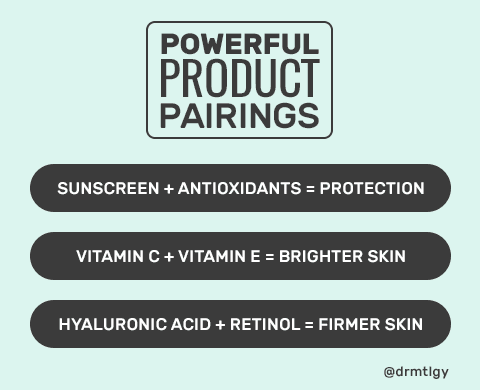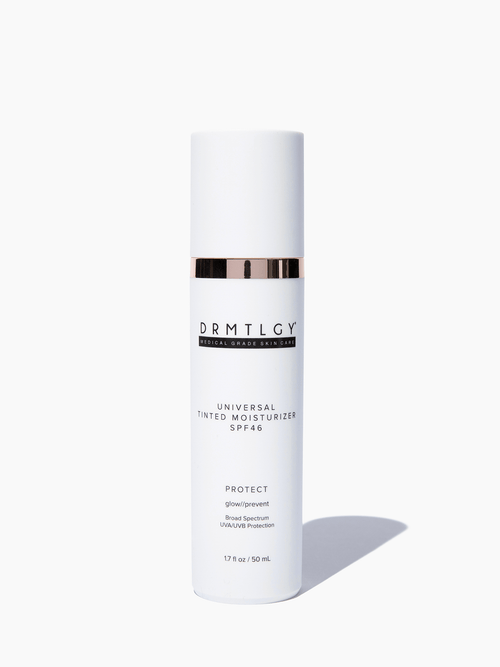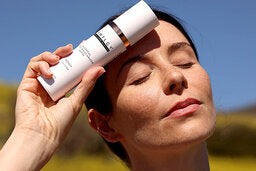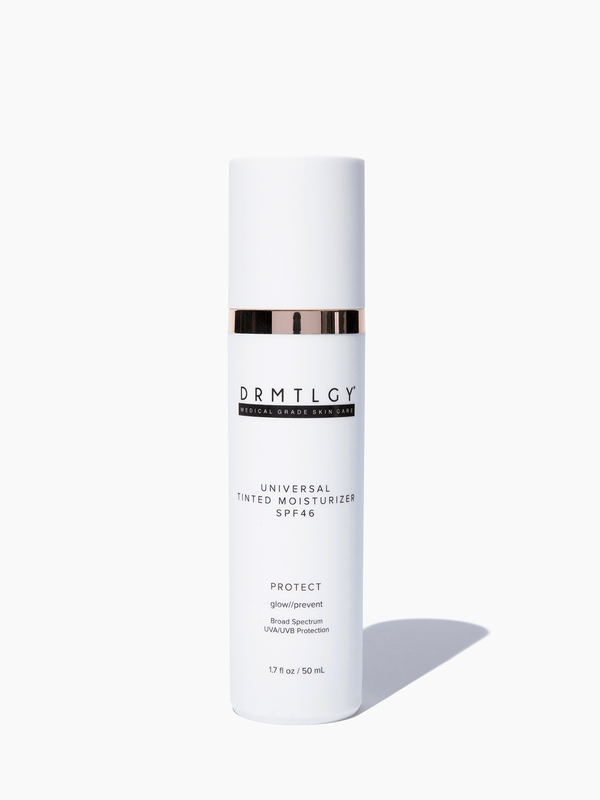Although incorporating several ingredient combinations into your skincare routine can do wonders for your skin, it’s easy to go overboard. Adding too many ingredients into a regimen increases the changes for a negative combination to take place, which can then set you back several steps in your journey towards your skincare goals.
But, by learning about these four skincare ingredient combinations, you can learn how to make your skincare routine work harder for you.
Let’s dive in!
3 Skincare Ingredient Combinations to Incorporate Into Your Routine

Sunscreen and antioxidants.
Damage from the sun’s harmful ultraviolet rays takes a huge toll on your skin’s overall health. In fact, it accounts for up to 90% of premature skin aging. This is why sun protection -- and adequate sun protection at that -- is imperative.
But even with the best intentions in mind, not everyone is willing or able to protect their skin to the level that is necessary to avoid radiation damage. And because we’re human and fallible, full sun protection is still not guaranteed.
So what’s a concerned skincare user to do?
According to research, the next best thing would be to add a serum full of antioxidants to your current skincare regimen. What this does is boost the effects of your sunscreen and add another layer of protection against the sun’s damaging rays.
How does this work?
UV radiation produces free radicals, which then cause damage by stealing an electron from neighboring molecules in your body. This can seriously mess up your skin cells, proteins, and even your DNA.
Here’s the kicker: A study has shown that sunscreen can only block about 55% of all free radicals created by UV radiation.
By incorporating a dependable antioxidant-heavy skincare product like the Advanced C E Ferulic, you can extend the amount of protection your skin has against the sun’s rays. Antioxidants like vitamin C and vitamin E neutralize free radicals, preventing them from destroying your cells.
To begin reaping the benefits of this potent combination, apply a layer of your favorite antioxidant product (we prefer a serum), to clean damp skin before you head out for the day. Continue with your daytime skincare routine as usual, and finish it up with a quarter-sized amount of sunscreen applied liberally to your face, neck, and ears.
(For more tips on how to apply sunscreen effectively, take a look at this guide.)
Vitamin C and vitamin E.
And while we’re on the topic of antioxidants, vitamin C and vitamin E are another noteworthy pairing to consider adding to your arsenal as well.
In addition to playing an important role in collagen production, vitamin C also fights hyperpigmentation and lends brightness to skin. Vitamin E is another well-known compound that works to renew your skin cells.
Just like the SPF and antioxidant combination we learned earlier, doubling down on antioxidants can boost their effectiveness too. In the case of these two, vitamin C increases the amount of vitamin E available in the skin. Meanwhile, vitamin E makes vitamin C work up to four times harder.
So if the relationship between sunscreen and antioxidants didn’t make you reach for your trusted serum immediately, this may very well change your mind. Just a few drops before you’re out the door every day, and your skin will thank you.
Hyaluronic acid and retinol (or hydroxy acids).
Retinol products and hydroxy acids like salicylic or glycolic acid can be irritating for the skin -- especially if you’re just starting out with skincare, or if your skin’s on the sensitive side.
The best way to soothe redness and irritation are hydrating ingredients like hyaluronic acid. These hardworking molecules can carry up to 1000 times their weight in water, making them an effective way to deliver moisture straight to your skin cells.
For best results, add this superstar to your morning and nighttime routines and watch your skin visibly improve! Plumpness, bouncy skin, and a healthy glow can be yours with the help of hyaluronic acid.
And despite its name, this gentle ingredient can be used in combination with practically any other one -- not just actives. So whenever you feel like your skin could use an extra boost of moisture, don’t be afraid to reach for it.
Just make sure to apply it to a damp face; otherwise, the molecules will absorb moisture from your skin instead... Not exactly what we’re looking for.
The #1 Ingredient Combination to Avoid
Benzoyl peroxide and retinol (or hydroxy acids).
Unfortunately, there are skincare ingredient combinations that don’t work quite as well as the first three we talked about. Benzoyl peroxide used with retinols or acids are at the top of that list.
Using any of these two combinations in the same routine (or even on the same day) can do some serious damage to your body’s largest organ, without a doubt. If you don’t want to end up with irritated, red, peeling or even rashy skin, avoid these combinations at all costs.
If you really insist on using one of these combinations in your own regimen, stagger your usage throughout the week (and not on subsequent days). So, for example, you may want to use your benzoyl peroxide product on Monday night and then the Retinol Complex 0.5% on Wednesday night.
And as always, don’t forget to hydrate, moisturize, and apply sunscreen thoroughly every day!
(Not sure what the difference between hydrating and moisturizing is? Don’t worry -- we’ve got you covered.)
If you need any help, feel free to turn to our team of trusted skincare experts. We’re here to help you!
References
International Journal of Cosmetological Science, April 2008, Volume 30, Issue 2, pages 87-95
Journal of Investigative Dermatology, October 2003, Volume 121, Issue 4, pages 862-868














